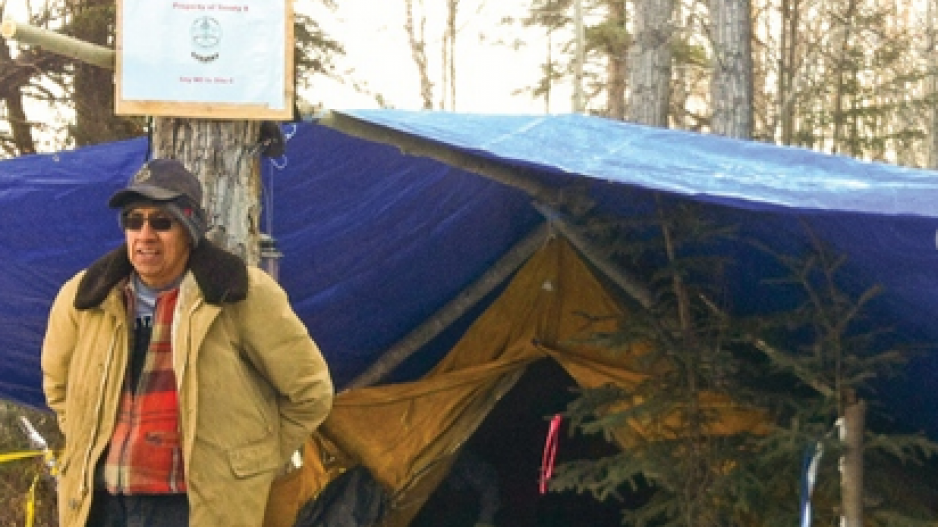Opponents of the Site C dam project have set up at the site of the Rocky Mountain Fort, a provisioning post where explorers Alexander MacKenzie and David Thompson took refuge and the earliest European settlement in mainland B.C.
While BC Hydro has said it will remove any significant artifacts from the fort, the site itself is set to disappear beneath the dam's 83-kilometre reservoir.
Rocky Mountain Fort was lost to history until the mid-70s, according to Arthur Hadland, who as a regional district director sought to have the site recognized for its historical significance.
"I tried the province—that was a waste of time," he said. "They would not touch it, they just blew it off. "
The fort lies upstream from the mouth of the Moberly River, on the south bank of the Peace. The outline of the fort's palisade wall is still visible.
The site was established some time after Alexander Mackenzie's 1793 quest for a route to the Pacific Ocean, according to a 1990 article by archaeologists David Burley and Scott Hamilton in the journal BC Studies. It was abandoned by 1804 for Fort St. John, then located at the mouth of the Beatton River.
Mackenzie noted an abundance of animals in the region, which caught the attention of fur trappers with the North West Company.
The company had expanded its trapping operations into what is now Northern Alberta, and needed meat to provision its crews. Early archaeologists discovered "tens of thousands" of splintered animal bones on the Rocky Mountain Fort site, suggesting it was used for grease rendering.
Local First Nations hunters supplied much of the game, making Rocky Mountain Fort one of the first sites of sustained contact between European explorers and Indigenous people in the Peace.
One such hunter, working freelance, brought in a total of 14,848 pounds of fresh meat to the fort, according to the journal of a North West Company officer.
"It's the whole significance of that site, being so symbolic for whites and First Nations," said dam opponent Ken Boon, of the decision to start a protest camp there alongside Treaty 8 members. "The fact is that it's been ignored by our provincial government and our federal government in the past."
Few knew about the fort until 1976, when Dr. Knut Fladmark, an archaeologist with Simon Fraser University, rediscovered it after reading a description of the site in David Thompson's journal.
Fladmark discovered "trade beads, lead ball, shot, lead sprue and small fragments of brass sheet metal" littered about the site, as well as the remains of three stone chimneys, a steel button, a knife blade and the bowl of a "Micmac"-style pipe.
"This site is remarkably well-preserved and completely unaffected so far by modern disturbances," Fladmark wrote in 1985.
The 2014 report of the Site C joint review panel noted Rocky Mountain Fort would be inundated should the dam be built, despite Hydro's plan to mitigate the loss through "relocation, systematic data recovery, capping, monitoring and compensation in-kind (replication)."
While sections of the south bank downstream of the Moberly River have been logged, the site of the fort remains untouched. However, the area is slated for clearing, which will take place through the first three months of 2016.
At some point, boat traffic will be restricted, making site access an issue, Boon said.
Site C spokesperson Dave Conway said Hydro is aware of the encampment, but noted it is "not presently interfering with our on-site construction activities" in an email.
As of December 14, it was not known how many people were living at the camp.
Boon said it remains to be seen whether there will be a confrontation over the site.
"I guess we'll see," he said. "(Hydro) keeps saying they're going to put (construction) buoys in, and I see they say that initially, boats will be able to pass through that area. So I guess we'll see what they decree."
Alaska Highway News



